In geometry, a near-miss Johnson solid is a strictly convex polyhedron whose faces are close to being regular polygons but some or all of which are not precisely regular. Thus, it fails to meet the definition of a Johnson solid, a polyhedron whose faces are all regular, though it "can often be physically constructed without noticing the discrepancy" between its regular and irregular faces.[1] The precise number of near-misses depends on how closely the faces of such a polyhedron are required to approximate regular polygons.
Some near-misses with high symmetry are also symmetrohedra with some truly regular polygon faces.
Some near-misses are also zonohedra.
Examples
| Name Conway name | Image | Vertex configurations | V | E | F | F3 | F4 | F5 | F6 | F8 | F10 | F12 | Symmetry |
|---|---|---|---|---|---|---|---|---|---|---|---|---|---|
| Associahedron t4dP3 |  | 2 (5.5.5) 12 (4.5.5) | 14 | 21 | 9 | 3 | 6 | Dih3 order 12 | |||||
| Truncated triakis tetrahedron t6kT |
 |
4 (5.5.5) 24 (5.5.6) |
28 | 42 | 16 | 12 | 4 | Td, [3,3] order 24 | |||||
| Pentahexagonal pyritoheptacontatetrahedron | 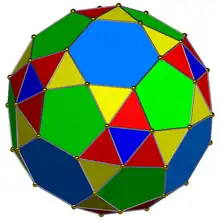 |
12 (3.5.3.6) 24 (3.3.5.6) 24 (3.3.3.3.5) |
60 | 132 | 74 | 56 | 12 | 6 | Th, [3+,4] order 24 | ||||
| Chamfered cube cC |
 |
24 (4.6.6) 8 (6.6.6) |
32 | 48 | 18 | 6 | 12 | Oh, [4,3] order 48 | |||||
| -- |  |
12 (5.5.6) 6 (3.5.3.5) 12 (3.3.5.5) |
30 | 54 | 26 | 12 | 12 | 2 | D6h, [6,2] order 24 | ||||
| -- |  |
6 (5.5.5) 9 (3.5.3.5) 12 (3.3.5.5) |
27 | 51 | 26 | 14 | 12 | D3h, [3,2] order 12 | |||||
| Tetrated dodecahedron |  |
4 (5.5.5) 12 (3.5.3.5) 12 (3.3.5.5) |
28 | 54 | 28 | 16 | 12 | Td, [3,3] order 24 | |||||
| Chamfered dodecahedron cD |
 |
60 (5.6.6) 20 (6.6.6) |
80 | 120 | 42 | 12 | 30 | Ih, [5,3] order 120 | |||||
| Rectified truncated icosahedron atI |
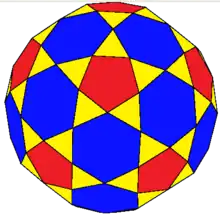 |
60 (3.5.3.6) 30 (3.6.3.6) |
90 | 180 | 92 | 60 | 12 | 20 | Ih, [5,3] order 120 | ||||
| Truncated truncated icosahedron ttI |
 |
120 (3.10.12) 60 (3.12.12) |
180 | 270 | 92 | 60 | 12 | 20 | Ih, [5,3] order 120 | ||||
| Expanded truncated icosahedron etI |
 |
60 (3.4.5.4) 120 (3.4.6.4) |
180 | 360 | 182 | 60 | 90 | 12 | 20 | Ih, [5,3] order 120 | |||
| Snub rectified truncated icosahedron stI |
 |
60 (3.3.3.3.5) 120 (3.3.3.3.6) |
180 | 450 | 272 | 240 | 12 | 20 | I, [5,3]+ order 60 |
Coplanar misses
Some failed Johnson solid candidates have coplanar faces. These polyhedra can be perturbed to become convex with faces that are arbitrarily close to regular polygons. These cases use 4.4.4.4 vertex figures of the square tiling, 3.3.3.3.3.3 vertex figure of the triangular tiling, as well as 60 degree rhombi divided double equilateral triangle faces, or a 60 degree trapezoid as three equilateral triangles. It is possible to take an infinite amount of distinct coplanar misses from sections of the cubic honeycomb (alternatively convex polycubes) or alternated cubic honeycomb, ignoring any obscured faces.
Examples: 3.3.3.3.3.3
 Rhombic prism
Rhombic prism
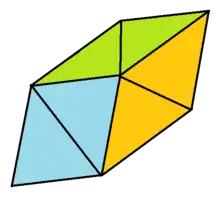
 Gyroelongated trigonal pyramid
Gyroelongated trigonal pyramid Triangulated monorectified tetrahedron
Triangulated monorectified tetrahedron
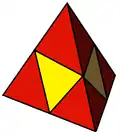 Tetratetrahedron, triangulated tetrahedron
Tetratetrahedron, triangulated tetrahedron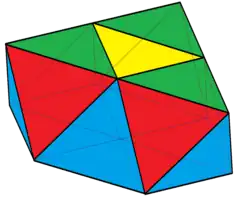 Augmented triangular cupola
Augmented triangular cupola Triangulated truncated triangular bipyramid
Triangulated truncated triangular bipyramid

 Hexagonal antiprism,
Hexagonal antiprism,
Gyroelongated hexagonal pyramid


4.4.4.4
3.4.6.4:
 Hexagonal cupola
Hexagonal cupola
(Degenerate)
See also
References
- ↑ Kaplan, Craig S.; Hart, George W. (2001), "Symmetrohedra: Polyhedra from Symmetric Placement of Regular Polygons", Bridges: Mathematical Connections in Art, Music and Science (PDF).
External links
- Near-miss Johnson solid, Polytope Wiki (74)
- Johnson Solid Near Misses, Polyhedra by Jim McNeil (31)
- Near Misses, Craig S. Kaplan (5)
